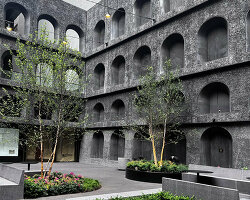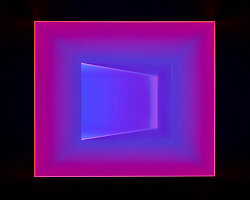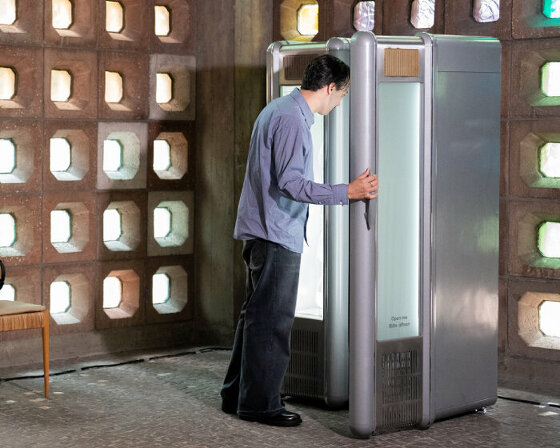an exhibition presenting the work of american artist adam pendleton and ghanaian-british artist and architect sir david adjaye has opened at pace gallery’s hong kong location. the exhibition features a new body of paintings by pendleton entitled ‘untitled (WE ARE NOT)’, presented in visual and spatial dialogue with a set of sculptural works by adjaye. viewed in concert, the works articulate a shared visual lexicon that explores questions of language, identity, and monumentality.
with the exhibition on view until june 30, 2021, designboom speaks with both pendleton and adjaye, as well as oliver shultz, curatorial director at pace gallery, to learn more about the presentation.

installation views by kitmin lee, courtesy of pace gallery
the two artists first met in 2016 while pendleton was installing a solo exhibition at the museum of contemporary art denver, a building designed by adjaye. in the years that followed, their continued dialogue revealed a mutual interest in the politics of space and representation, as well as the relationship between art and architecture. ‘I’m drawn to david’s work as a visual idea,’ pendleton tells designboom. ‘his work relates sculptural experimentation to the pragmatic realities architecture so often has to address.’ david adjaye, who was recently awarded the 2021 royal gold medal for architecture, adds: ‘I think what’s beautiful about the commonality in our work is the question of form and how it supports space, perception, and, in a sense, a dialogue between the two’.

originating from pendleton’s seminal ‘black dada’ text of 2008, the phrase ‘WE ARE NOT’ is broken down and merged to form all-over compositions. pendleton’s reiteration and reconfiguration of his own past language extends the dynamics of his ongoing ‘black dada’ project — a conceptual framework through which the artist explores ideas about the future through the evocation of the past, with an emphasis on the relationship between blackness and the avant-garde. presented on the walls of pace’s hong kong gallery, the ‘untitled (WE ARE NOT)’ paintings similarly address questions of historical and collective definition, alluding obliquely to the rhetoric of contemporary identity politics.

occupying the floor of the gallery, adjaye’s modular geometric sculptures take the form of pyramids, yet are composed of individual elements with the capacity to be reconfigured in a variety of orientations. in this way, they echo the combinatorial possibilities of language explored in pendleton’s paintings. working in marble — which is also among the most frequently used materials in the history of architecture — has enabled adjaye to distill broader ideas about materiality and form into objects that trouble the boundaries between art and architecture, while evoking the history of minimal sculpture.
read more about the work in our interviews with the artists and pace’s curatorial director below.

designboom (DB): compared with your architectural projects, what is your approach to creating art and sculpture?
david adjaye (DA): I’m very interested in this idea of blurring what you think an artwork is and allowing it to perform in different ways. as a question on process, the possibility of asking what the potential of form is and could be is something that heavily plays out within my practice as both artist and architect.
I work within a framework of relationality as a lens through which to see the temporal intricacies between form and material. this movement opens up an exploration into the interplay of memory and history which documents a past-time, the disaggregated potential of the monoform which documents a present-time, and the desire of the collective or individual to document a future-time.

DB: what similarities and common themes do you see in your work and the work of adam pendleton?
DA: I think what’s beautiful about the commonality in our work is the question of form and how it supports space, perception, and, in a sense, a dialogue between the two. I found that one of the elements that evolved within the works was this idea of language as form. this is seen in the geological process of marble formation which creates a type of stone scripting and in adam’s paintings — which are like graffiti — relaying language in a state of its own seeking. both are forms of becoming in which language and form and language as form contain a multiplicity of differences, directions, meanings, and interpretations while still maintaining a universality birthed at the requirement of abstraction.
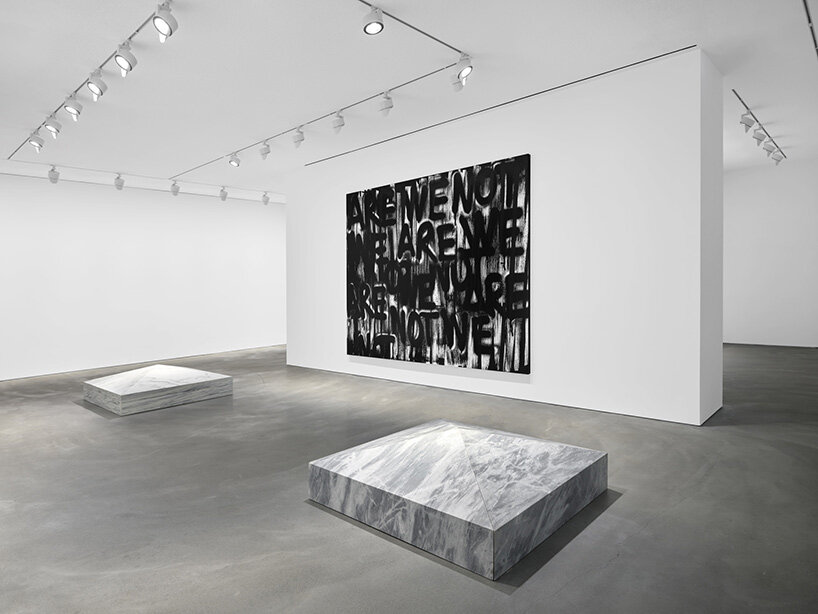
designboom (DB): how did this new body of paintings come about? what influenced you creatively?
adam pendleton (AP): I’ve been working on the WE ARE NOT paintings since 2018. one day I was revisiting a text I wrote in 2008 called ‘black dada’ and came across the sentence: we are not naïve, we are successive, we are not exclusive . . .
I often use short, unresolved statements in my work as visual material. language is often how the work announces itself, even just on a figurative level. the field of the painting is where the language becomes physical, plastic, handled, worked and reworked, wild. I want to challenge legibility and form, the potential of the mark, and the necessity and possibilities of abstraction. ‘we are not’ re-folds into many phrases: NOT WE ARE, ARE ARE WE NOT . . . many forms and representations that are incomplete and perpetually becoming.

DB: what interests you about david adjaye’s work? how do you view the relationship between art and architecture?
AP: I’m drawn to david’s work as a visual idea. his work relates sculptural experimentation to the pragmatic realities architecture so often has to address. his buildings are objects deserving of intimate attention in the ways they belie form and draw you in through sensory realities, color and structure. he brings new conceptual and formal dynamics to architecture that elevate what we desire and expect from architects.

designboom (DB): how do you view the relationship between art and architecture?
oliver shultz (OS): for both pendleton and adjaye, abstraction is really the central axis through which art and architecture intersect. both a strategy and a method as well as an object of inquiry, abstraction has always been fundamental to adam’s work, especially insofar as it becomes an agent for the idea of the universal or collective. the same might be said of david’s approach to architecture, which abstracts ornament and pattern into structure — transmuting individual elements from the singular mark to the plural field — while deconstructing cultural artifacts and reshaping their fragments into a kind of unified aesthetic system. this is closely related to what adam does with language in his densely layered fields of graphic marks — repeatedly overlaying the words ‘we are not,’ writing and over-writing — to generate the incredibly complex surfaces of his paintings.

OS (continued): it goes without saying that art and architecture are entwined historically, sociologically, and ontologically. but what adam’s and david’s works draw our attention to are the specific ways in which this relationship turns on certain key dialectics: chaos and order, temporality and historicity, duration and durability, as well as the structures and limits of language and belonging. in the work of both adam and david, this deep imbrication between art and architecture is important not just because the two fields are mutually constitutive; it is important because both are interested in the more fundamental questions that such mutuality raises, as well as the political possibilities it might open up.

DB: how did this exhibition develop? what led to the pairing of pendleton and adjaye’s work?
OS: adam and david have long been aware of each other’s work, for which they’ve shared both mutual admiration and a sense of affinity. adam has talked about the experience of his 2016 exhibition at the museum of contemporary art in denver, ‘becoming imperceptible,’ as a key moment in that exchange. adam’s work often takes the form of installation and depends on a highly tuned and responsive relationship to the built environment and architectural context in which the work appears. adam has talked about how his experience of working in a space designed by adjaye — actually the first museum he designed in north america — played an important role in catalyzing his interest in collaboration. the two have been in dialogue ever since, and now that conversation is taking concrete shape.

adam pendleton, untitled (WE ARE NOT), 2020, silkscreen ink on canvas, 96″ × 69″ (243.8 cm × 175.3 cm)
image © adam pendleton, courtesy of pace gallery
DB: in this exhibition, how do the paintings by pendleton engage with the sculptures by adjaye?
OS: the surfaces, textures, and material qualities of the adjaye’s sculptures and pendleton’s paintings produce a really powerful interaction that is both visual and conceptual, and which speaks very directly to processes of time and temporality. adam has compared his surfaces both to graffiti and to fresco, two ends of the spectrum of painterly marks historically connected to the wall as both architectural structure and social space. in pendleton’s paintings, as in graffiti, marks originate as words but drift from their meanings. they erode and become faded like frescos, subject to the entropic properties of time, disappearing even as they become visible.

adam pendleton, untitled (WE ARE NOT), 2020, silkscreen ink on canvas, 96″ × 120″ (243.8 cm × 304.8 cm) | image © adam pendleton, courtesy of pace gallery
OS (continued): what adjaye calls the ‘geological writings’ in his marble forms are similarly traces of time’s operation. millennia of tectonic forces — the immense pressure of the earth pressing into itself — have deposited those lines in the stone. the calligraphic and aleatory energy of pendelton’s densely layered lettering rhymes with the meandering veins in the marble. meanwhile the precise and linear edges of adjaye’s geometries are suggestive of the mechanism of language; yet at the same time, they allow for the possibility for what adjaye calls the ‘primary forms’ of the pyramidal sculpture to ‘disaggregate’ into smaller individual triangles, much as language itself dis-aggregates and breaks down on the surface of pendleton’s paintings.

david adjaye, khufu, 2021, nero marquina marble, honed, 108″ x 108″ x 24″
image © david adjaye, courtesy of pace gallery
OS (continued): in each of their bodies of work, david and adam are asking us to consider what form can do: how marks, or patterns, or indeed textures of experience might open the possibility for there to be an ‘us.’ how does collective experience begin? for pendleton, language is also a ‘primary form,’ which, like the architecture of a pyramid, speaks to what can be at once universal and culturally specific.
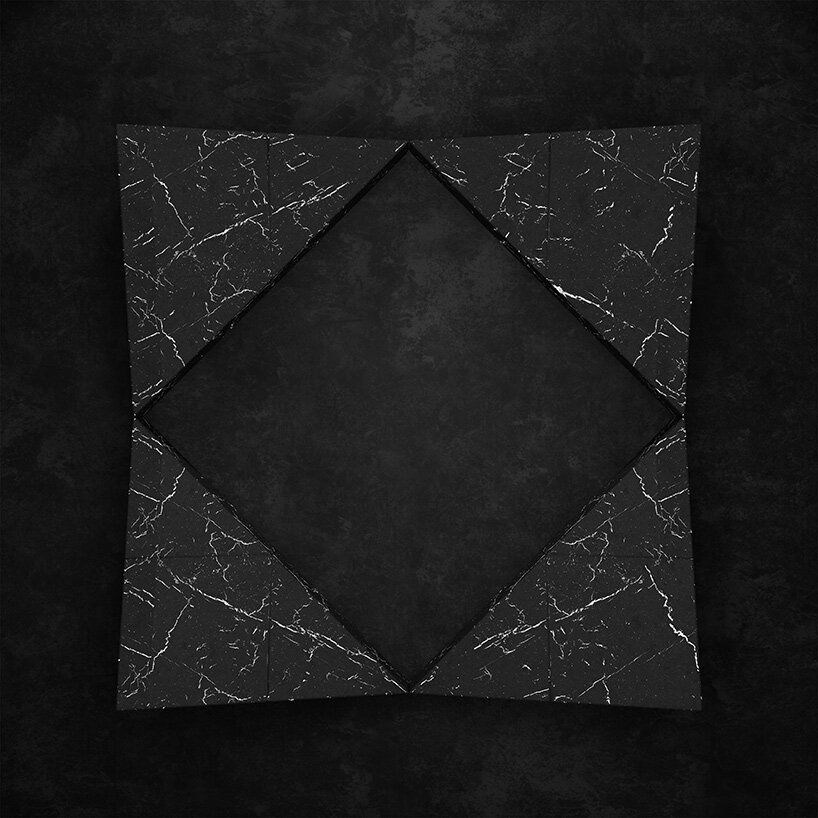
david adjaye, khufu, 2021, nero marquina marble, honed, 108″ x 108″ x 24″
image © david adjaye, courtesy of pace gallery
OS (continued): adjaye and pendleton are together reminding us that like pyramids, culture and language are both constructed — deeply human — as well as universal and elemental. insofar as architectures are ordered spaces that we inhabit collectively, adam’s and david’s works also disrupt that seamlessness, producing moments of disjuncture or illegibility. these ruptures have political potential precisely because they refuse functionality and access even while seeming to grant it.








exhibition info:
name: david adjaye adam pendleton
location: pace gallery — hong kong
address: 12/F, H queen’s, 80 queen’s road central, hong kong
dates: may 18 – june 30, 2021
artists: david adjaye and adam pendleton
david adjaye (117)
pace gallery (15)
PRODUCT LIBRARY
a diverse digital database that acts as a valuable guide in gaining insight and information about a product directly from the manufacturer, and serves as a rich reference point in developing a project or scheme.


